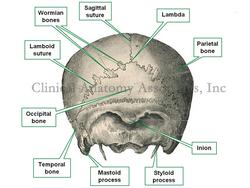UPDATED: The root term [-mast-] arises from the Greek [μαστός] or [mastos] meaning "breast". A synonymous prefix is [mamm-] from the Latin [mamma], also meaning "breast". This prefix is used in medical terms such as:
- Mastectomy: The suffix [ectomy] means "removal of". Removal of the breast. This is an old operation, the first known records are from 180 A.D. The modern operation for radical mastectomy with careful removal of the related lymphatics was developed by William Halsted (1852 - 1922). The synonym [mammectomy] is correct, though rarely used. The word [masectomy] to refer to this procedure is incorrect and should not be used
- Mastoptosis: The suffix [-(o)ptosis] means "to fall", "to sag" or "go down". A falling or sagging of the breast. (Syn. mammoptosis)
- Mastoid: The suffix [oid] means "similar to". Similar to a breast or with the shape of a breast, such as the mastoid process, a bony prominence of the temporal bone. See accompanying image
- Mastoplasty: The suffix [-(o)plasty] is used to mean "surgical reshaping". Surgical reshaping of the breast. Better known as a mammoplasty
- Mastopexy: A type of mastoplasty. The suffix "opexy" is used to mean "surgical fixation". Surgical fixation of the breast. In a mastopexy, the breast is "fixed" higher to reduce the mastoptosis. (Syn. mammopexy)
There is an interesting evolution of this word. The above applies only when the term [-mast-] is used as a root term, and combined with other word components. From the Greek, this term was passed on to Latin and thence evolved with the German term [m?sten] meaning "to feed" or "to fatten". This is why we have [mast cells] in histology. These are a type of mononuclear leukocyte described by Paul Ehrlich (1814 - 1915) in 1879, who named them [maztellen], which in German means "a well-fed cell".
For images of mastoptosis and mastopexy, CLICK HERE. Warning: images depict nude bodies.
Sources:
1. "The Origin of Medical Terms" Skinner, HA 1970 Hafner Publishing Co.
2. "Dorland's Illustrated Medical Dictionary" 28th Ed. W.B. Saunders. 1994
3. "Medical Terminology; Exercises in Etymology" Dunmore CW, Fleischer RM 2nd Ed. 1985
4. "Medical Meanings; A Glossary of Word Origins" Haubrich, WS. Am Coll Phys 1997




